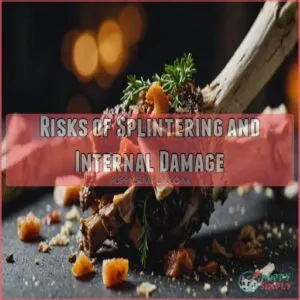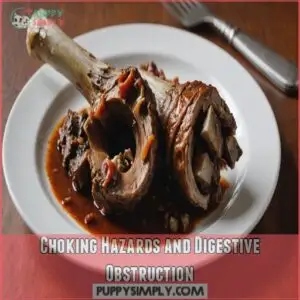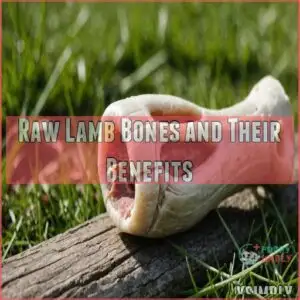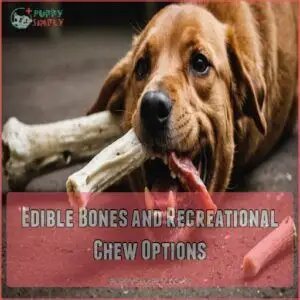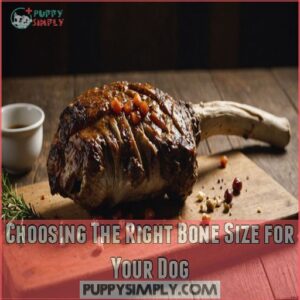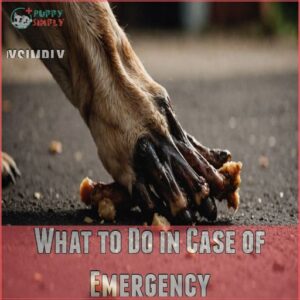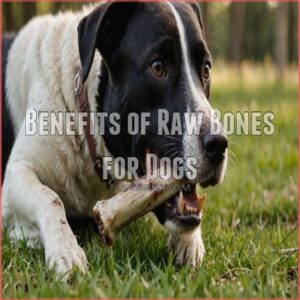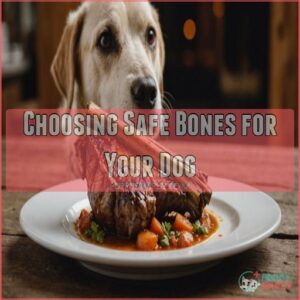This site is supported by our readers. We may earn a commission, at no cost to you, if you purchase through links.
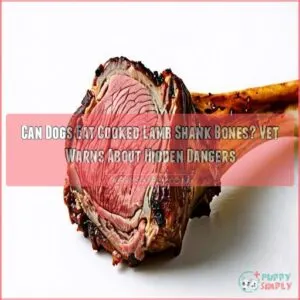 You shouldn’t feed your dog cooked lamb shank bones – they’re a recipe for disaster.
You shouldn’t feed your dog cooked lamb shank bones – they’re a recipe for disaster.
When cooked, these bones become brittle and can splinter into sharp fragments that might tear through your pup’s digestive tract.
Just like you wouldn’t want to swallow glass shards, these bone splinters can cause serious internal injuries, choking, or life-threatening blockages.
While your furry friend might give you those irresistible puppy eyes, there are much safer ways to satisfy their natural urge to chew.
Raw bones or specially designed chew toys can provide the same satisfaction without putting your four-legged family member at risk.
Table Of Contents
- Key Takeaways
- Dangers of Cooked Lamb Bones
- Safe Alternatives for Your Dog
- What to Do in Case of Emergency
- Benefits of Raw Bones for Dogs
- Choosing Safe Bones for Your Dog
- Frequently Asked Questions (FAQs)
- Can a dog eat a cooked lamb shank?
- Can a dog eat a lamb bone?
- Can dogs eat cooked bones?
- Can dogs eat lamb?
- Can I give a cooked lamb shank bone to my dog?
- What should I do if my dog ate a cooked lamb bone?
- What cooked bones can dogs eat?
- Can dogs chew on cooked beef shank bones?
- How long can dogs chew on lamb shank bones?
- Should puppies be given lamb shank bones?
- Can large breeds handle cooked bones better?
- Do lamb bones cause tooth damage over time?
- Are store-bought smoked lamb bones safer than home-cooked?
- Conclusion
Key Takeaways
- Never feed your dog cooked lamb shank bones – they’ll splinter into sharp fragments that can tear through their digestive tract and cause life-threatening injuries.
- Watch for signs of bone ingestion problems including frequent vomiting, changes in bathroom habits, lethargy, loss of appetite, and belly pain – contact your vet immediately if you notice these symptoms.
- You can offer safe alternatives like raw beef bones, dental chews, bully sticks, or Kong toys filled with frozen treats to satisfy your dog’s natural urge to chew.
- If your dog is choking on a bone, try to remove visible pieces, perform the Heimlich maneuver if needed, and call your vet right away – quick action could save their life.
Dangers of Cooked Lamb Bones
While your dog’s pleading eyes might tempt you to share that leftover lamb shank bone, keep in mind that raw bones like raw pork bones can harbor bacteria and pose serious risks. You’ll want to resist those puppy dog looks since cooked bones can splinter and cause serious internal injuries.
You’re much better off tossing that cooked bone in the trash and understanding the risks of cooked bones which can splinter and cause mouth injuries, offering your pup a safe alternative like a raw bone or durable chew toy instead.
Risks of Splintering and Internal Damage
Inside your dog’s mouth, cooked lamb shank bones can become a hidden menace.
When heated, these bones turn brittle and prone to splintering, creating sharp fragments that pose serious risks.
Watch out for these dangerous scenarios:
- Cuts and scrapes in your dog’s mouth and gums
- Tears in the sensitive throat tissue
- Punctures in the stomach lining
- Perforations in the intestinal walls
These injuries aren’t just painful – they can quickly lead to life-threatening infections.
Choking Hazards and Digestive Obstruction
Beyond the risk of splintering, cooked lamb shank bones can become lodged in your dog’s throat, creating a scary choking hazard.
What starts as a tasty treat can quickly turn into an emergency vet visit if bone fragments block their digestive tract.
Think of it like trying to swallow a mouthful of sharp toothpicks – it’s just not worth the risk to your furry friend.
Signs of Bone Ingestion and Illness
If your dog’s eaten a cooked lamb bone, you’ll want to watch for these red flags.
Here’s what veterinarians say to look out for:
- Unusual vomiting or retching, especially if it’s frequent
- Changes in bathroom habits, including diarrhea or straining
- Lethargy and loss of appetite that’s out of character
- Whining or guarding their belly, which could signal abdominal pain
If you’re unsure about what bones are safe, check out products specifically labeled as lamb bone dog safe.
Keep your vet’s number handy – quick action can save lives.
Safe Alternatives for Your Dog
You’ll be relieved to know there are plenty of safe alternatives to those risky cooked lamb shank bones your pup’s been eyeing.
Raw beef bones and specialized dental chews can give your dog the satisfying chewing experience they crave without putting their health at risk.
Raw Lamb Bones and Their Benefits
Raw lamb bones offer a safer alternative that can keep your dog’s tail wagging.
They’re naturally spongy and packed with nutrients that support your pup’s health.
Here’s what you need to know about raw lamb bones:
| Benefit | How It Works | Impact on Your Dog |
|---|---|---|
| Dental Care | Natural scraping action | Removes plaque and tartar |
| Joint Health | Rich marrow content | Provides glucosamine |
| Mental Health | Extended chewing time | Reduces anxiety and boredom |
| Physical Exercise | Jaw muscle engagement | Strengthens mouth muscles |
Edible Bones and Recreational Chew Options
Looking for safe chewing options for your pup?
Consider edible alternatives like bully sticks, dental chews, or Kong toys filled with frozen treats.
Remember that raw lamb or goat bones can provide a natural abrasive action for dental cleaning.
These options provide the satisfaction of chewing without the risks of cooked bones.
You’ll also find specially designed dental toys that massage gums and clean teeth.
For a natural approach, try carrots or apple slices – they’re crunchy, healthy treats your dog will love.
Choosing The Right Bone Size for Your Dog
Measuring your furry friend’s chew strength is important when selecting bones.
For small dogs like Chihuahuas, opt for bones roughly the size of their head to prevent swallowing.
If you’re unsure about lamb shank bone size, visit lamb shank bone size for a better understanding of the size range available.
Medium breeds need thicker bones that match their jaw width, while large breeds can handle substantial bones like beef femur.
Watch closely during the first few chewing sessions to gauge your dog’s chewing style and adjust accordingly.
What to Do in Case of Emergency
If you’ve caught your dog with a cooked lamb shank bone, don’t panic – but you’ll need to act quickly to prevent potential health risks.
Whether your pup’s already swallowed some bone fragments or is showing signs of distress, you’ll find the essential emergency steps right here to help keep your furry friend safe.
Removing Cooked Bones From Your Dog’s Reach
Safeguard your furry friend by immediately removing all cooked lamb bones from areas they can reach.
Store bones securely in sealed containers or high cabinets, and make sure everyone in your household knows not to leave them accessible.
If you’ve got kids, explain why they shouldn’t share table scraps.
Consider investing in dog-safe chew toys as alternatives – they’ll keep your pup happy without the risks.
Steps to Take if Your Dog is Choking
If your dog’s choking on a bone, quick action can save their life.
Once you’ve cleared the area, follow these steps to help your furry friend:
- Open their mouth wide and look for any visible bone pieces you can safely remove.
- Place small dogs on your lap, head down.
- For larger dogs, perform the canine Heimlich by wrapping your arms around their belly.
- Apply quick upward thrusts behind their rib cage.
- Repeat until the bone dislodges.
Veterinary Guidance and Immediate Action
Every second counts when your dog’s in trouble with a bone.
Call your vet immediately – don’t wait to see if things improve.
They’ll guide you through emergency steps and tell you if you need to rush in.
Meanwhile, keep a close eye on your pup for signs like coughing, gagging, or difficulty breathing.
Quick action could save your dog’s life.
Benefits of Raw Bones for Dogs
You’ll be amazed at how safe bone portions can prevent choking hazards and internal injuries when introducing raw bones to your dog’s diet. Raw bones can transform your dog’s dental health while providing essential nutrients like glucosamine for healthy joints.
While cooked bones are dangerous, raw bones give your furry friend a natural way to exercise their jaw muscles and satisfy their instinctive urge to chew.
Keeping Teeth and Gums Healthy
Through consistent raw bone chewing, your dog’s dental health gets a natural boost.
Raw bones act like nature’s toothbrush, offering these key benefits for teeth and gums:
- Scrapes away tartar buildup naturally
- Massages gums to improve circulation
- Reduces bacteria that cause bad breath
- Helps prevent costly dental procedures
You’ll notice fresher breath and healthier-looking gums within weeks.
It’s like giving your pup a daily dental spa treatment they’ll actually enjoy.
Exercise and Stimulation for The Jaw
Raw bones work like a natural gym for your dog’s jaw muscles.
When your pup chomps down on a bone, they’re actually getting a full workout that keeps their jaw strong and healthy.
Here’s what happens during your dog’s chewing session:
| Activity | Muscle Benefit | Time Needed |
|---|---|---|
| Gnawing | Strengthens jaw | 10-15 mins |
| Crushing | Builds endurance | 5-10 mins |
| Grinding | Improves control | 8-12 mins |
| Holding | Develops stability | 3-5 mins |
| Carrying | Enhances grip | 2-4 mins |
Nutritional Benefits of Raw Bones
Marrow-rich bones pack a powerful nutritional punch for your furry friend.
When you give your dog raw bones, they’re getting natural sources of glucosamine and chondroitin, which help keep their joints healthy and moving smoothly.
The bone marrow itself is loaded with essential nutrients that support immune function and overall health.
Plus, the act of chewing raw bones promotes better digestion and helps maintain strong teeth.
Choosing Safe Bones for Your Dog
You’ll want to think twice before tossing your dog that leftover lamb shank bone from dinner, as cooked bones can splinter and cause serious internal injuries.
While your pup’s pleading eyes might be hard to resist, you can keep them safe and satisfied by choosing appropriate alternatives like raw beef bones or specially designed chew toys.
Bone Types to Avoid for Dogs
While bones can clean your dog’s teeth, not all bones belong in their bowl.
You’ll want to steer clear of these risky options.
For instance, cooked lamb chop bones are particularly hazardous, as explained in lamb chop bone risks.
Cooked bones of any kind – they splinter like glass and can tear up your pup’s insides.
Chicken and turkey bones – they’re too brittle, even when raw.
Pork bones and fish bones – these break easily and can get stuck.
Think of it like giving a toddler a lollipop with sharp edges – just not worth the risk.
Supervision and Monitoring for Safe Bone Chewing
Keeping a watchful eye on your dog during bone-chewing sessions isn’t just about safety—it’s about understanding their chewing style.
Here’s a quick guide to monitoring your pup:
If you’re in the market for lamb bone alternatives, consider durable lamb bone chew toys for a safer option.
| Behavior | What to Watch | Action Needed |
|---|---|---|
| Aggressive | Crushing attempts | Remove bone |
| Casual | Gentle gnawing | Continue supervision |
| Obsessive | Won’t let go | Limit time |
Always stick around during chewing sessions and remove the bone if it gets too small or shows signs of splintering.
Healthy Alternatives to Cooked Lamb Bones
Now that you know how to watch your pup with bones, let’s explore some safer options that’ll keep your dog happy and healthy.
You’ve got plenty of choices that won’t put your furry friend at risk:
- Raw beef bones (specifically knuckle bones) offer safe chewing fun
- Dental chews designed for your dog’s size
- Bully sticks provide long-lasting entertainment
- Rubber chew toys made for aggressive chewers
These alternatives give your dog the same satisfaction without the dangers of cooked bones.
Frequently Asked Questions (FAQs)
Can a dog eat a cooked lamb shank?
No, you shouldn’t feed your dog cooked lamb shanks.
They can splinter easily and cause serious injuries to your pet’s mouth, throat, or intestines.
Stick to raw bones or safer chew toys instead.
Can a dog eat a lamb bone?
Raw lamb bones can harbor bacteria like Salmonella in raw lamb, but if handled properly, they can be safe for your dog to chew, but avoid giving them cooked ones as they splinter easily.
Large, raw lamb bones provide dental benefits and entertainment while keeping your pup safe.
Can dogs eat cooked bones?
Cooked bones are dangerous for your dog – they’ll splinter easily and can cause serious injuries to their mouth, throat, and digestive system.
It’s best to stick with specially made chew toys instead.
Can dogs eat lamb?
Like a gentle shepherd guarding its flock, lamb meat offers great nutrition for your dog.
You can safely feed your pup plain, cooked lamb in moderation – it’s packed with protein and essential nutrients.
Can I give a cooked lamb shank bone to my dog?
You shouldn’t give your dog cooked lamb shank bones – they pose a serious risk of puncturing the digestive tract due to their tendency to splinter easily like cooked bones. They’re dangerous and can splinter easily, potentially causing serious internal injuries.
Stick to raw bones or specially made dog chews for safer chewing options.
What should I do if my dog ate a cooked lamb bone?
Time’s ticking like a stopwatch – contact your vet immediately.
Monitor for vomiting, lethargy, or bloody stool.
Remove any remaining bone pieces from your dog’s reach and watch their bathroom habits closely.
What cooked bones can dogs eat?
Cooked bones, including those from ribs and other small bones, can cause choking hazards and intestinal blockages, aren’t safe for dogs to eat – they can splinter and cause serious internal injuries.
Never feed your dog any cooked bones, whether they’re from chicken, beef, pork, or lamb.
Can dogs chew on cooked beef shank bones?
Feeding dogs cooked beef shank bones isn’t safe.
They can splinter and cause serious internal injuries.
It’s best to stick with raw bones or safer chewing alternatives that won’t risk your pup’s health.
How long can dogs chew on lamb shank bones?
Like a ticking clock in a dog’s paradise, you shouldn’t let your pup chew raw lamb shank bones for more than 15-20 minutes at a time.
Monitor them closely and remove the bone if it becomes small enough to swallow.
Should puppies be given lamb shank bones?
Raw lamb shank bones aren’t safe for puppies – they’re too hard for developing teeth and jaws.
Wait until your pup’s at least 6 months old, and always supervise their chewing to prevent accidents.
Can large breeds handle cooked bones better?
Hard as steel, cooked bones can shatter like glass – and size doesn’t make them safer.
Even your big breed’s powerful jaws won’t protect them from dangerous splinters.
Don’t risk your furry friend’s safety.
Do lamb bones cause tooth damage over time?
Properly chosen lamb bones won’t damage your dog’s teeth – they actually help clean them!
However, you’ll want to stick with raw bones since cooked ones can wear down enamel and potentially crack teeth.
Are store-bought smoked lamb bones safer than home-cooked?
Store-bought smoked lamb bones aren’t safer than home-cooked ones – they’re still processed with heat, making them prone to splintering.
You’ll want to stick with raw bones to keep your pup safe.
Conclusion
Regarding the age-old question "can dogs eat cooked lamb shank bones," the answer’s crystal clear – it’s a million times safer to skip them altogether.
Your pup’s health isn’t worth the risk of splintering bones and emergency vet visits.
Instead, treat your furry friend to raw bones under supervision or try specially designed chew toys.
Remember, keeping your dog safe and healthy doesn’t mean they can’t enjoy a good chew – it just means making smarter choices.

